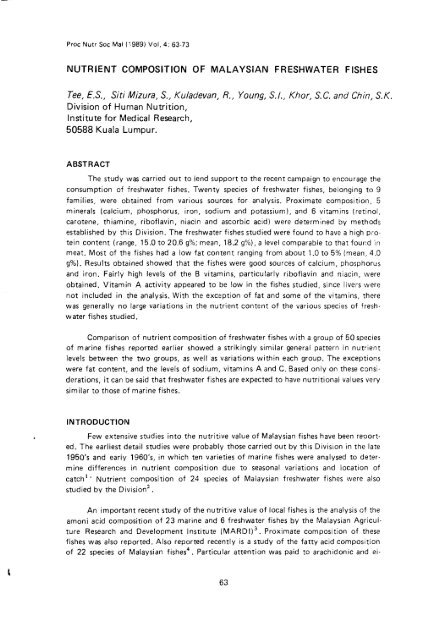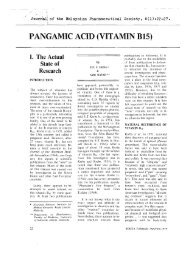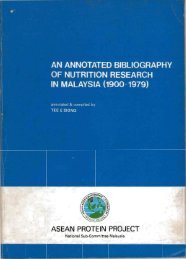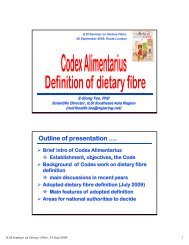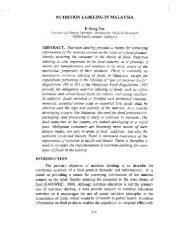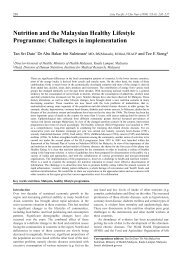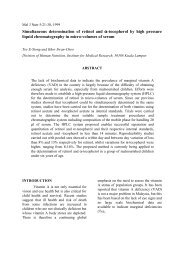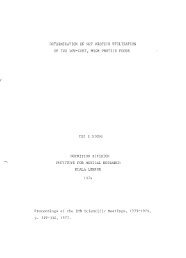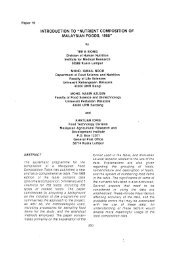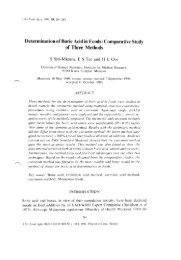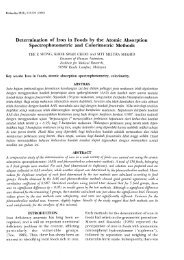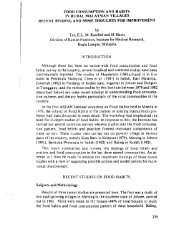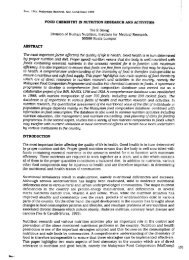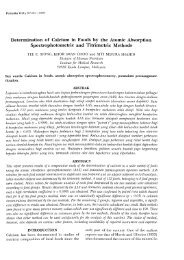Nutrient composition of Malaysian freshwater fishes.
Nutrient composition of Malaysian freshwater fishes.
Nutrient composition of Malaysian freshwater fishes.
You also want an ePaper? Increase the reach of your titles
YUMPU automatically turns print PDFs into web optimized ePapers that Google loves.
Proc Nutr Soc Mal (1·989) Vol. 4: 63·73NUTRIENT COMPOSITION OF MALAYSIAN FRESHWATER FISHESTee, E.5., 5iti Mizura, 5., Kuladevan, R., Young, 5.1." Khor, S.C. and Chin, S.K.Division <strong>of</strong> Human Nutrition,Institute for Medical Research,50588 Kuala Lumpur.ABSTRACTThe study was carried out to lend support to the recent campaign to encourage theconsumption <strong>of</strong> <strong>freshwater</strong> <strong>fishes</strong>. Twenty species <strong>of</strong> <strong>freshwater</strong> <strong>fishes</strong>, belonging to 9families, were obtained from various sources for analysis. Proximate <strong>composition</strong>, 5minerals (calcium, phosphorus, iron, sodium and potassium), and 6 vitamins (retinol,carotene, thiamine, rib<strong>of</strong>lavin, niacin and ascorbic acid) were determined by methodsestablished by this Division. The <strong>freshwater</strong> <strong>fishes</strong> studied were found to have a high pro·tein content (range, 15.0 to 20.6 g%; mean, 18.2 g%), a level comparable to that found inmeat. Most <strong>of</strong> the <strong>fishes</strong> had a low fat content ranging from about 1.0 to 5% (mean, 4.0g%). Results obtained showed that the <strong>fishes</strong> were good sources <strong>of</strong> calcium, phosphorusand iron. Fairly high levels <strong>of</strong> the B vitamins, particularly rib<strong>of</strong>lavin and niacin, wereobtained. Vitamin A activity appeared to be low in the <strong>fishes</strong> studied, since livers werenot included in the analysis. With the exception <strong>of</strong> fat and some <strong>of</strong> the vitamins, therewas generally no large variations in the nutrient content <strong>of</strong> the various species <strong>of</strong> fresh·water <strong>fishes</strong> studied.Comparison <strong>of</strong> nutrient <strong>composition</strong> <strong>of</strong> freshwatE!r <strong>fishes</strong> with a group <strong>of</strong> 50 species<strong>of</strong> marine <strong>fishes</strong> reported earlier showed a strikingly similar general pattern in nutrientlevels between the two groups, as well as variations within each group. The exceptionswere fat content, and the levels <strong>of</strong> sodium, vitamins A and C. Based only on these consi·derations, it can be said that <strong>freshwater</strong> <strong>fishes</strong> are expected to have nutritional values verysim ilar to those <strong>of</strong> marine <strong>fishes</strong>.INTRODUCTIONFew extensive studies into the nutritive value <strong>of</strong> <strong>Malaysian</strong> <strong>fishes</strong> have been report·ed. The earliest detail studies were probably those carried out by this Division in the late1950's and early 1960's, in which ten varieties <strong>of</strong> marine <strong>fishes</strong> were analysed to deter·mine differences in nutrient <strong>composition</strong> due to) seasonal variations and location <strong>of</strong>catch I . <strong>Nutrient</strong> <strong>composition</strong> <strong>of</strong> 24 species <strong>of</strong> <strong>Malaysian</strong> <strong>freshwater</strong> <strong>fishes</strong> were alsostudied by the Division" ,An important recent study <strong>of</strong> the nutritive value <strong>of</strong> local <strong>fishes</strong> is the analysis <strong>of</strong> theamoni acid <strong>composition</strong> <strong>of</strong> 23 marine and 6 <strong>freshwater</strong> <strong>fishes</strong> by the <strong>Malaysian</strong> Agricul·ture Research and Development Institute (MARDI)3. Proximate <strong>composition</strong> <strong>of</strong> these<strong>fishes</strong> was also reported. Also reported recently is a study <strong>of</strong> the fatty acid <strong>composition</strong><strong>of</strong> 22 species <strong>of</strong> <strong>Malaysian</strong> <strong>fishes</strong> 4 • Particular attention was paid to arachidonic and ei·63
cosapentaenoic acid levels in these <strong>fishes</strong>. Content <strong>of</strong> several trace metals has beenreported for various species <strong>of</strong> finfish and shellfish s ,6.Recognizing the im ponance <strong>of</strong> fish in the <strong>Malaysian</strong> diet, a systematic programmeto characterize the nutrient <strong>composition</strong> <strong>of</strong> this food item was carried out by OLir laboratory.The <strong>composition</strong> <strong>of</strong> 50 species <strong>of</strong> marine <strong>fishes</strong> commonly available in the localmarkets has bElen studied and recently reported by the authors 7. The present study wascarried out to lend support to the recent campaign to encourage the consumption <strong>of</strong><strong>freshwater</strong> <strong>fishes</strong>. This report presents the nutrient <strong>composition</strong> <strong>of</strong> 20 species <strong>of</strong> <strong>freshwater</strong><strong>fishes</strong> studied.MATERIALS AND METHODSFishes for analysis were purchased from the market and other retail outlets. Severalspecies were obtained from the Fishery Department <strong>of</strong> the Ministry <strong>of</strong> Agriculture andthe Facu ltv <strong>of</strong> Fisheries and Marine Science, Universiti Pertanian Malaysia (U PM)_Except for 7 species which were difficult to obtain, duplicate samples <strong>of</strong> each <strong>of</strong> theremaining 13 species were obtained from differe~1t sources for analysis.The <strong>fishes</strong> were first weighed as purchased/obtained. The non-edible portions(<strong>of</strong>fal, bones, and scales) were removed and weighed to determine percentage <strong>of</strong> edibleportion in each fish. Sufficient quantity <strong>of</strong> the edible portion was taken for immediatedetermination <strong>of</strong> ascorbic acid. The remaining edible portions <strong>of</strong> the <strong>fishes</strong> were blendedand aliquots weighed out for the various analyses.All analyses were performed according 1:0 the methods given in the laboratorymanual compiled by this laboratorya. Moisture was determined by the air-oven method,protein by the semi-micro Kjeldahl methOd, fat was extracted using the soxhlet, and ashcontent was determined after incinerating the fish in a muffle. Carbohydrate content wasthen determined by difference. Energy content Df the <strong>fishes</strong> was calculated by multiplyingthe protein, carbohydrate and fat content with the factors 4,4 and 9 respectively.Five minerals were determined. Calcium was determined by titration against potassiumpermanganate. Phosphorus was determ ined after reaction with the vanadate-molybdatereagent, and iron content was similarly estimated colorimetrically through itsreaction with o-phenanthroline_ Sod ium and potassium were deterrn ined using atom ic absorptionspectrometry.Vitam in A and carotene were first extracted from the unsaponifiable fraction <strong>of</strong> thesaponification mixture and then chromatographed on a column <strong>of</strong> alumina. The provitaminand vitamin A thus separated were read separately in a spectrophometer. Totalvitamin A activity in the <strong>fishes</strong> was calculated from the sum <strong>of</strong> retinol concentration and1/6 the concentration <strong>of</strong> carotene. Thiamine was determined using the thiochrome procedure,whilst rib<strong>of</strong>lavin was estimated in a fluorometer. Niacin concentration was colorimetricallydetermined after reaction with cyanogen bromide and sulphanilic acid. Theindophenol dye titration method was used for the estimation <strong>of</strong> ascorbic acid content <strong>of</strong>the <strong>fishes</strong>_64
RESULTS AND DISCUSSIONAll the 20 species <strong>of</strong> <strong>freshwater</strong> <strong>fishes</strong> studied are listed in Table 1, grouped accord.ing to the 9 families <strong>of</strong> the <strong>fishes</strong>. The Bahasa Malaysia and scientific names <strong>of</strong> the <strong>fishes</strong>are listed with the English or common names. For identification and naming <strong>of</strong> the <strong>fishes</strong>,the chart produced by the Fisheries Department <strong>of</strong> the Ministry <strong>of</strong> Agriculture and thebook published by UPM 9 have been particularly useful..Tables 2, 3 and 4 tabulate the proximate <strong>composition</strong>, minerals and vitaminsrespectively <strong>of</strong> the <strong>fishes</strong> studied. An examination <strong>of</strong> these detailed results, Itogether withsome descriptive statistics in Tables 5, 6 and 7 gilves an idea <strong>of</strong> the pattern or trend <strong>of</strong>nutrient <strong>composition</strong> <strong>of</strong> these <strong>fishes</strong>.Edible portion <strong>of</strong> majority <strong>of</strong> the <strong>fishes</strong> studied was about 50%. Water and proteincontent <strong>of</strong> these <strong>fishes</strong> did not show large variations. Mean moisturH content was 76.8g%. while protein content <strong>of</strong> most <strong>of</strong> the <strong>fishes</strong> was around the mean <strong>of</strong> 18.2 g'Yo. Mineralash made up approximately another 1.1% <strong>of</strong> the <strong>fishes</strong>; this was also rather similar for allthe <strong>fishes</strong> studied.Of the macro-nutrients studied, fat content showed the most variation amongst the<strong>fishes</strong> studied. This is clearly evident from a comparison <strong>of</strong> the coefficient <strong>of</strong> variation(CV) <strong>of</strong> these nutrients (Table 5). Most <strong>of</strong> the <strong>fishes</strong> had a fat con ten t ranging from about1.0 to 5%, Some <strong>of</strong> the <strong>fishes</strong> studied had higher fat contents close to 10 g%, while a fewhad levels below 1 g%. As a result <strong>of</strong> this, energy content, calculated from protein, car·bohydrate and fat, showed a slightly larger variation.Mineral content <strong>of</strong> the <strong>fishes</strong> studied can be seen to be rather similar for the variousspecies, except for a few extreme values. Compared to the macro-nutrients, however,there was greater variability, as indicated by the larger CV values (Table 6). Calciumcontent <strong>of</strong> most <strong>fishes</strong> was around 20·35 mg% (mean, 36 mg%), and that <strong>of</strong> phosphorusaround 190 mg%. Iron level was frequently not more than 1.0 mg%. Sodium concen·tration for most <strong>fishes</strong> was around 20 to 50 m~I%, and potassium content was in theregion <strong>of</strong> 250 to 300 mg%.Carotene was not detected in most <strong>of</strong> the <strong>fishes</strong> studied. Vitamin A activity (expressedas fJ.g retinol equivalent) <strong>of</strong> <strong>freshwater</strong> <strong>fishes</strong> was not high, with considerablevariation amongst the various species. Vitamins in general showed larger variations, exceptfor niacin content. Vitamin Bl content <strong>of</strong> theSE! <strong>fishes</strong> was also low, with half <strong>of</strong> the<strong>fishes</strong> having a level <strong>of</strong> less than the mean value <strong>of</strong> 0.03 mg%. Rib<strong>of</strong>lavin content,however, was generally higher than that <strong>of</strong> thiamine; most <strong>of</strong> the <strong>fishes</strong> had a vitamin 82content <strong>of</strong> over 0.05 mg%, while five <strong>of</strong> them had a level <strong>of</strong> over 0.3 mg%. Niacin level inmost <strong>of</strong> the <strong>fishes</strong> was in the region <strong>of</strong> 2 mg%. Very low levels <strong>of</strong> ascorbic acid were detectedin the <strong>fishes</strong> stud ied.65
Family English Name Bahasa Malaysia Name Scientific Name Item No. inTables 2 - 4Anaban1idae Climbing perch Pu yu/Betok Anabas rewdinesu 6Giant gouramy Kalui Osphronemus goramy 9KiSSing gouramy TemakanglTebakang Helostoma temmincki 14Snakeskin gouramy Sepat siam T richogaster pectoralis 91Bagridae River catfish Baung Mysws nemurus 16Cichlidae African bream Tilapia Tilapia mossambicaAfrican bream, red Tilapia merah Tilapia spp.Clanldae Catfish Keli Clarias barrachu.< 5(j) Cyprinidae B 19 head carp Kap kelala besar Aristicl1rhys nobilis3(j)Carp Tebal sisik Puntius binoratus 4Common carp Lee koh Cyprinus carpio 7Grass carp Kap rumput Ctenopharyngodon idellus 11Javar.ese carp Lampam Jawa Puntius gonionocus 12Jelawat Jelawar Leptobarbus hoevenii 13Rohu Rohu Labeo rohita 17Eleotridae Goby Kewtu Oxyeleotris marmoraWs 10Notopteridae Featherback Belida Noropterus spp. 8Qpf!lcephalidde (CildllIl idae) Snakeilead Haruan Ophlcephalus striatus 18Toman Toman Channa micropeltes 20Pal19a~idae (Schtilbetidae) Malaysia fiver .Patin Pangasius pangasius 15-Table 1. Lis1 <strong>of</strong> F reshwa1er Fishes Stud ied
Table 2Proximate Composition oi ~reshwater Fishes ,per 100 9 edible ;)ortlonlEdibleNo. Name ot Fish Portion Energy Water Protein Fat Carbohdrate Ash(%) {kcall {y) (9) (9) (g) (g)1. African bream 40 96 78.9 16.4 3.0 0.8 092. African bream, red 38 104 77.6 19.7 2.7 0 1.13. 319 nead carp 41 ld2 74.4 16.2 8.6 0 1 14.a Carp 39 161 71.6 18.0 99 0 0.95. Catlisn 52 113 75.3 19.3 3.8 0.5 1 , ~6.a Climbing perch .)0 141 730 '9.5 7.0 0 127. Common carp 46 91 79.4 15.0 2.6 2.0 1.08.a ~eat"erbaci< 57 105 75.7 20.1 2.5 0.5 1.29. Giant goura~y 42 110 75.9 19.0 3.8 02 ~ . I10. GODV 42 79 79.9 18.4 05 0.1 1 • ~11. Grass carp 51 104 79.2 17.6 3.7 0 1.012. ja'J anese carp 62 145 74.7 16.3 8.9 0 1.113. je!awat 50 165 70.6 18.8 01.0 0 1.114. rsphorus Iron Sodium Potassium1. African Dream 22 147 0.6 48 2532. African bream, red 25 194 0.6 31 2933. 3 ig head car;) 25 192 0.9 50 211..\ .3 CarD 24 173 1.4 23 2785. Ca rri sl1 31 206 1.2 33 3026.a Climo!ng percn 94 183 1.3 25 2687. Common carD 21 188 0.8 67 2868.3 Featl1erback 87 241 0.2 20 2609. Giant gOClramy ~9 187 0.3 21 32810. Gob'j 27 169 0.4 32 26911. Grass cam 21 179 1.1 49 17812 Javanese carp 32 190 0.7 41 30213. .iel3wat 35 187 1.6 34 30214. '
RetinolNo. N_me <strong>of</strong> Fish Retinol Carotene Equivalent Thiamine Rib<strong>of</strong>lavin Niacin Vitamin Clug~ (/lS) I/lSI Img) (mgl (mg) (m9)--Table 4: Vitamin Content <strong>of</strong> <strong>freshwater</strong> Fishes (per 100 9 edible portion)en(XI1. African bream 21 a 21 a 0.30 ].6 0.62. African bream, red 20 a 20 0 0.04 1.6 0.53. Big head carp 12 0 12 0.01 0.08 2.4 4.94.a Carp 151 0 151 0 0.05 2.0 2.35. Catfish 40 27 45 0.05 0.07 2.3 1.76.a Climbing carp 46 0 46 0.04 0.49 2.2 1.07. Common carp 26 0 26 a 0.06 2.3 0.38.a Featherback 92 a 92 a 0.03 3.9 5.29. Giant gouramy47 a470.05 0.062.5 0.710. Goby17 a170.01 0301.1 3.511. Grass carp 39 a 39 0.01 007 1.6 2.212. Javanese carp 36 a 36 a 0.06 2.0 0.513. Jelawat 22 a 23 0.05 0.02 1.7 2.014. Kissing gouramy 38 a 38 0.03 0.46 3.0 3.115. Malaysia river catfish 47 6 48 0.07 0.16 1.6 3.116.• River catfish 109 a 109 0 0.05 1.8 0.917 .• Rohu 5 a 5 0.01 0.08 2.7 018. Snakehead 45 0 45 0.03 0.13 2.6 1.419.a Snakeskin gouramy 25 0 25 0.12 0.36 1.8 2.620.• Toman 19 0 19 0.02 0.09 2.2 1.2------.--~~--.--.."AnalYSIS performed on Single sample. "(he,,. duplicate samples
Based on the detail results for 50 species <strong>of</strong> marine <strong>fishes</strong> previously reported bythe authors 7and the summary statistics tabulated in Tables 5, 6 and 7, some generalcomparisons <strong>of</strong> the nutrient <strong>composition</strong> <strong>of</strong> <strong>freshwater</strong> and marine <strong>fishes</strong> may be made.The macro·nutrients <strong>of</strong> the two groups <strong>of</strong> <strong>fishes</strong> showed striking similarities, both withregards to mean values and magnitude <strong>of</strong> variations between species within each group.The exception to this generalization was fat content, which tended to be slightly higher in<strong>freshwater</strong> <strong>fishes</strong>.Variation in fat content for matine <strong>fishes</strong> was considerably higher,attributed to the exceptionally high level <strong>of</strong> fat (23.0 g%) for longtail shad. Exclusion<strong>of</strong> this fish gave a fat content for marine <strong>fishes</strong> ranging from 0 to 6.6 g%, and a muchreduced CV <strong>of</strong> 81.4.Mineral content <strong>of</strong> the two groups <strong>of</strong> <strong>fishes</strong> was also rather similar, even withregards to their coefficients <strong>of</strong> variation. Sodium level, however, showed slightly greaterdifferences between the <strong>freshwater</strong> and marine <strong>fishes</strong>. Both groups <strong>of</strong> <strong>fishes</strong> also showedsimilar general patterns in vitamin content, although differences in CV values areobserved. In addition, vitamin A and C levels in <strong>freshwater</strong> <strong>fishes</strong> tended to be slightlyhigher.Results <strong>of</strong> Student's t·test <strong>of</strong> mean levels <strong>of</strong> nutrients for the two grcups <strong>of</strong> <strong>fishes</strong>are tabulated in the last two rows <strong>of</strong> Tables 5,6 and 7. It was found that there was nostatistically significant difference in mean levels for 6 <strong>of</strong> the 15 nutrients tabulated. Forthose nutrients where a significant difference was obtained, the t·value calculated wasnot exceptionally large.Fishes in general, therefore, have been found to be good sources <strong>of</strong> severalimportant nutrients. Biological value <strong>of</strong> protein in fish has been known to be comparableto that <strong>of</strong> other animal products such as milk and meat. In addition, unlike meat (D;.;ceptfor poultry), <strong>fishes</strong> have no religious prohibitions, and are thus consumed by all ethnicgroups in the country.Fish has been an important item in the diet <strong>of</strong> <strong>Malaysian</strong>s. Aside from consuming itas a dish in itself, fish is also used as a condiment in various traditional forms, such asdried, salted, and fermented, e.g. budu, belacan and ikan pekasam, FAD Food BalanceSheet! 0 showed that the average amount <strong>of</strong> fish and seafood available for food in thecountry from 1982·84 was 120.8 g per caput per day, although <strong>freshwater</strong> fis,hes made uponly 2.5% <strong>of</strong> this total. If this figure is taken as a rough indicator <strong>of</strong> consumption, it canbe seen that fish and seafood contributed significantly to the protein and energy intake <strong>of</strong>communities. Protein and energy contribution from these foods worked out to be 11.7 gand 58 kcal respectively, contributing to 20.2% <strong>of</strong> the total protein intake and 2.3% <strong>of</strong>that <strong>of</strong> energy.Fish plays a particularly important role in the diet <strong>of</strong> the rural population. Higherfigures <strong>of</strong> fish consumption have been reported for some rural villages in PeninsularMalaysia. From the study <strong>of</strong> food consumption pattern <strong>of</strong> villages in four states carriedout by the Institute for Medical Research, Kuala Lumpur!!, fish consumption (includingdried fish and other sea foods) was found to range from 124 to 230 g per caput per day.This level <strong>of</strong> consumption corresponded to the contribution <strong>of</strong> 34% <strong>of</strong> the total proteinconsumption and 4% <strong>of</strong> the total energy intake <strong>of</strong> these communities, which includedfishing villages.69
Table 5: Mean Levels <strong>of</strong> Selected Macro·<strong>Nutrient</strong>s in Freshwater and Manne I Fishes (per 100 9 edible portion)-------------------------Water (9) Energy (kea" Protein (g) Fat (g) Ash (9)Freshwater rJlarifle Freshwater Marine Freshwater Marine Freshwater Marine Freshwater MarineMean 76.8 76.5 110 100 18.2 20.2 4.0 2.0 1.1 1.3S.D. 2.7 3.2 26 30 1.6 1.6 3.1 3.4 O. ~ 0.1Minimum 70.6 59.4 79 74 15.0 17.5 0.2 0 0.9 1.1MaXimum 80.3 80.6 165 281 20.6 25.6 10.0 23.0 1.3 1.7C.V. 3.7 4.2 25 30 8.9 8.0 81.4 167.6 9.6 10.9n 20 50 20 50 20 50 20 50 20 50Calcium (mg) Phophorus (mg) Iron (mg) Sodium (mg) Potassium (mg)Freshwater Marine Freshwater Marine Freshwater Marine Freshwater Marine Freshwater MarineMean 36 43 192 210 0.8 0.6 31 99 270 318S.D. 24 29 22 44 0.4 0.4 14 81 56 71Minimum 11 9 147 80 02 0.2 10 32 86 130MaXimum 94 146 241 319 1.6 2.5 67 573 335 487C.V. 67 67 12 21 51.2 60.9 46 82 21 23n 20 50 20 50 20 50 20 50 20 50tcalcu~a{ed 1.00 1.73 1.31 3.63 2.61Significance NS NS NS P
RetinolEquivalent (pg) Thiamine (pg) Rib<strong>of</strong>lavin (mg) Niacin (mg) Vitamin C (mg)Freshwater Marine Freshwater Marine Freshwater Marine Freshwater Marine Freshwater MarineMean 43 22 0.03 0.08 0.15 0.14 2.1 2.9 1.9 0.3S.D. 35 10 0.03 0.10 0.14 0.09 0.6 1.0 1.4 0.5Minimum 5 4 0 0 0.02 0.03 1.1 1.0 0 0Maximum 151 48 0.12 0.60 0.49 0.44 3.9 7.1 5.2 2.0C.V. 83 45 124.8 124.9 99.9 69.5 29.0 35.7 78.7 187.6n 20 50 20 50 20 50 20 50 20 50Table 7: Mean Levels <strong>of</strong> Vitamins in Freshwater and Marine' Fishes (per 100 9 edible portion)--.Jtcalculated 3.84 2.35 0.41 3.03 6.59Significance p < 0.01 P < 0.05 NS p< 0.01 p < 0.01I from Tee et at. 7
CONCLUSIONSThe <strong>freshwater</strong> <strong>fishes</strong> studied had a high protein content (ranging from 15.0 to 20.6g%). a level comparable to that found in meat. Fat content varied considerably, and wasgenerally lower than that in meat. Freshwater <strong>fishes</strong> were also good sources <strong>of</strong> the Bvitamins, particularly rib<strong>of</strong>lavin and niacin. Vitamin A activity appeared to the low in the<strong>fishes</strong> studied, since the livers were not included in the analysis. Results obtained alsoshowed that <strong>freshwater</strong> <strong>fishes</strong> were good sources <strong>of</strong> calcium, phosphorus and iron. 'Niththe exception <strong>of</strong> fat and some <strong>of</strong> the vitamins, there was generally no large variations inthe nutrient content <strong>of</strong> the various species <strong>of</strong> <strong>freshwater</strong> <strong>fishes</strong> studied.Comparison <strong>of</strong> nutrient <strong>composition</strong> <strong>of</strong> <strong>freshwater</strong> <strong>fishes</strong> with a group <strong>of</strong> marine<strong>fishes</strong> studied earlier showed a strikingly similar general pattern in nutrient levels andvariations within each group. The exceptions were fat content, and the levels <strong>of</strong> sodium,vitamins A and C. Based only on these considerations, it can be said that <strong>freshwater</strong> <strong>fishes</strong>are expected to have nutritional values very similar to those <strong>of</strong> marine <strong>fishes</strong>.The Government has implemented various measures to encourage development <strong>of</strong>aquaculture. The production <strong>of</strong> fresh and brackish water aquaculture fish has beenincreasing over the years, and several species have become increasingly popular and fetchremunerative pricE'S. These measures could have a great impact on the nutritional status <strong>of</strong>large segments <strong>of</strong> the communities, as well as increasing the income <strong>of</strong> fishermen.ACKNOWLEDGEMENTSWe thank the Fishery Department <strong>of</strong> the Ministry <strong>of</strong> Agriculture and the FaCUlty <strong>of</strong>Fisheries and Marine Science, Universiti Pertanian Malaysia, for their assistance in obtainingsome species <strong>of</strong> fish for analysis. We would also like to thank Dr. M. Jegathesan,Director <strong>of</strong> the Institute, for Medical Research for permission to publish this paper.REFERENCES1 Institute for Medical Research (IMR), Analysis <strong>of</strong> Malayan sea·fish. Annual Report 1960,' KualaLumpur: Institute for Medical Research, 1961; pp. 29-31.2 Institute for Medical Research. Analysis <strong>of</strong> <strong>freshwater</strong> fish. Annual Report 1961: Kuala Lumpur:Institute for Medical Research, '1962; pp. 42-44.3 Zanariah J, Noor Rehan A, Rosnah O. Amino acid <strong>composition</strong> <strong>of</strong> local marine and <strong>freshwater</strong><strong>fishes</strong>. Report No. 269; Serdang: Food Technology Division, MARDI, 1983.4 Gibson RA, Kneebone R, Kneebone GM. Comparative levels <strong>of</strong> arachidonic acid and eicosapentaenoicacid in MalaYsian fish. Comp Biochem Physio/1984; 78C(2):325·328.5 Lee KH. Cobalt and nickel in <strong>Malaysian</strong> finfish and shellfish. Proceedings <strong>of</strong> the Symposium onImproving the Quality <strong>of</strong> Life in Malaysia: the Role <strong>of</strong> Chemistry; 24·26 March 1977, KualaLumpur; pp. 103·108.6 Low TP Lee KH. Essential trace elements in <strong>Malaysian</strong> finfish and shellfish: vanadium, chrom,um.mangan~se and molybdenum. Proceedings <strong>of</strong> the Conference on Chemical Research in Malaysia,19·21 March 1979. Kuala Lumpur; pp. 127·133.7 Tee ES, Sit; Mizura S. Kuladevan R, et ai_ <strong>Nutrient</strong> <strong>composition</strong> <strong>of</strong> <strong>Malaysian</strong> marire <strong>fishes</strong>. ASEAN Fd J 1987; 3:67-71. 72
8 Tee ES, Siti Mizura S. Kuladevan R, et al. (editors). Laboratory Procedures in <strong>Nutrient</strong> Analysis <strong>of</strong>Foods. Kuala Lumpur: Institute for Medical Research, 1987.9 Mohmmad Mohsin AK, Mohd. Azmi Ambak. Freshwater Fishes <strong>of</strong> Peninsular Malaysia. Serdang:Universiti Pertanian Malaysia, 1983.10 FAO Food Balance Sheets, 1982-84 Average. Rome: Food and Agriculture Organization. 1988(unpublished) .11 Chong YH. Tee ES, Ng TKW. et al. Status <strong>of</strong> community nutrition in poverty kampungs. BullerinNo. 22 Kuala Lumpur. Insrirute for Medical Research, 1984.73


